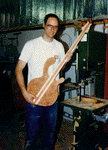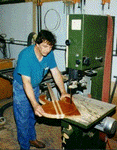"Mesquite Basses and Guitars From Texas"
 |
I am self taught as a luthier. In 1992 I left the Army and returned to the University of Texas. I was playing 5-string bass guitar in a Surf-rock band in Austin when I noticed deficiencies in the instrument that I owned. I looked around for a good replacement and didn't find one that met my expectations. Either they were just retreaded "vintage" designs with an extra string, or they were the very trendy and not very practical designs.
I began to do some research on what it takes to make a musical instrument. I went to several libraries and read about instrument construction, and not only guitars, but the violin family and other instruments as well. I started getting parts catalogs. I bought some books. I spent a lot of time talking to musicians and asking them what they wanted in an instrument. I went to shops and looked at the state of the art. I also asked dealers what they saw as good or salable traits.
|
| Over the next several years, I began to apply the knowledge that I had gained, and began to build prototype instruments. Each of these in turn worked out to be a playable instrument of increasing quality. I worked with several woodworkers, looking for one who was willing to take a chance and had the openness of mind to help me translate my concepts to practical reality. One opined: "We just made you a cutting board in the shape of a guitar, its up to you to make it into an instrument."
It was during this prototyping that I was introduced to Texas Mesquite. I grew up in northwest Texas, where Mesquites are regarded as a pest shrub, whose dense thorns hide cattle from their cowboys. Given ample water, a Mesquite tree can grow quite large indeed. Trees this large are rare, and indeed there are only about 4 commercial mills in Texas that utilize the wood. Most ends up in charcoal, but some is made into fine furniture and flooring. |

|
 | Mesquite is rare among woods in that it expands and shrinks to changes in moisture equally in all directions. Most woods expand 2-3 times more across the grain than along it, which is why moisture changes can warp necks or bodies. Mesquite, being isometric, is an ideal neck wood.
I began to use straight grained Mesquite, laminated with figured Maple for the neck blanks on most of the instruments. The combination is very durable. Having two woods of different densities (Mesquite is 20% heavier than Maple) helps to reduce "Dead" spots and "wolf" notes in the neck because each species resonates at different frequencies, helping reduce the standing wave interference that causes these phenomenon. |
|
Certain Mesquite trees will burl up, exhibiting crazy twisted grain. I laminated a 1/4" (6.4 mm) top of this rare timber to Honduras Mahogany. The lighter, resonant Mahogany has a warm and full tone that it is famous for, and the addition of the Mesquite adds bite and attack to the tone. These prototypes gained some attention, and I found myself accepting orders for instruments. What started as a practical exercise to satisfy myself has become a business. The "I" became a "we" and now we are able satisfy the needs/wants/desires of others. We have now come to the point where we no longer are making one-offs but we have standardized much of the character of our instruments, rather than each one being unique. While standardized, each one has ample room for customization, should the customer want something different. Rather than telling the customer what to buy, we ask him what he needs. If it is within our boundaries, we take it on. If not, we won't hesitate to recommend another maker. | |
| We currently focus on the $1500 to $2500 range for prices, which separates us from the production instruments, but is still within the reach of most professional (and many non-professional) musicians. Our bass line includes our standard bass in 4, 5, 6 or 8 string models and a 30" scale baritone 6 string model. Our guitar line consists of a pair of similar semi-acoustic models, one neck through body and the other set-neck construction. We also build two models of electric upright bass. One is a 35" scale travel bass that uses standard bass guitar strings and is less than a meter (39") long. The other is a full 41 1/2" scale instrument with a scrolled peghead. Our unique transducers give excellent tone either with a bow or with fingers, without the harshness of typical piezo crystals, and the semi-hollow body gives great depth to the sound. |  |
|
Many manufacturers simply copy what has already been done, refusing to innovate or make any big steps. It is safe business, but the result is that 90% of the bass guitars sold in the world are copies of models that were introduced in the 1950s. We have taken a different approach, first searching for new components and durable materials for the instruments, then integrating the components and the structure into a balanced whole. Playability is important, so balance and comfort are carefully worked out, making the instruments less fatiguing to play. We have sourced parts and electronics from all over the world. Seymour Duncan has been very helpful in getting us the pickups and preamps we need, and we make our own piezoelectric sensors. When many people see the fine woods in our guitars, they are surprised and say "I thought electric guitars were made of plastic" because of the thick, glossy polyurethane paint used by most manufacturers to hide the cheap, generic woods they use. We are currently the only maker in the world that we know of who uses Texas Mesquite wood in a production setting. | |
Visit Ranger Bob's website: http://www.hembrook.com
or
send him e-mail ranger_bob@hembrook.com